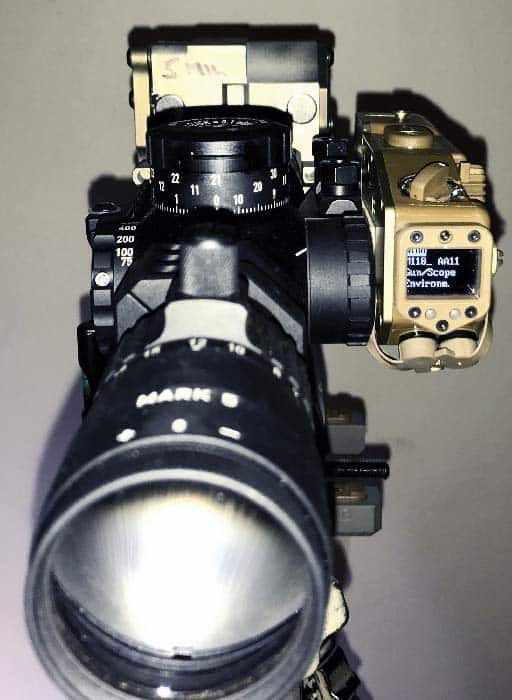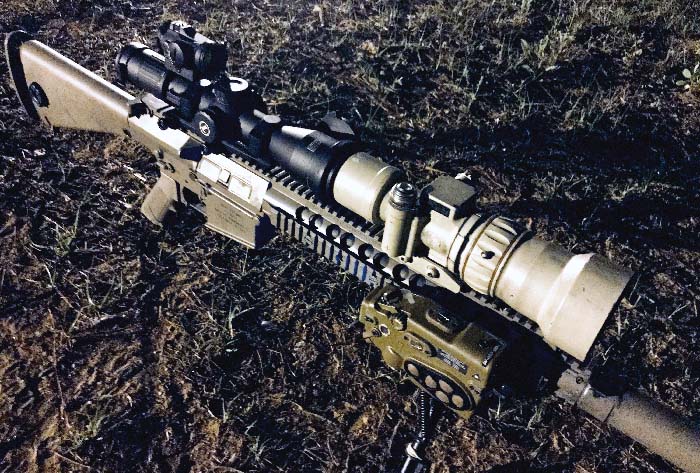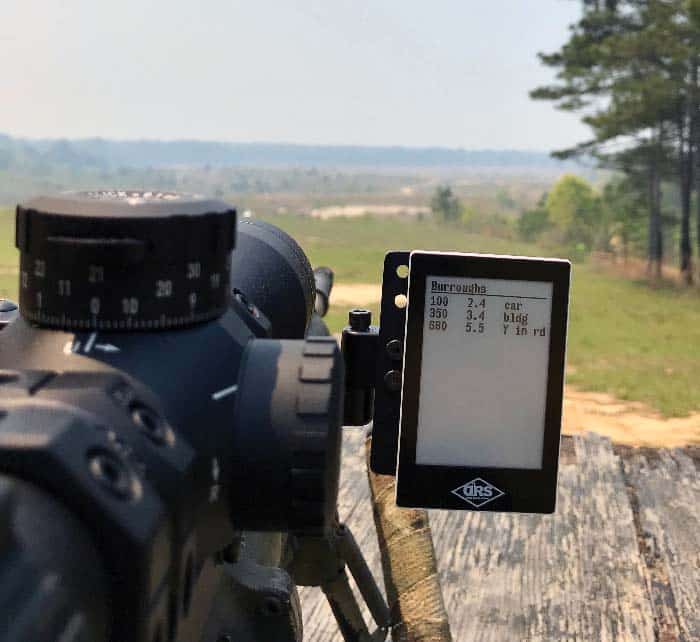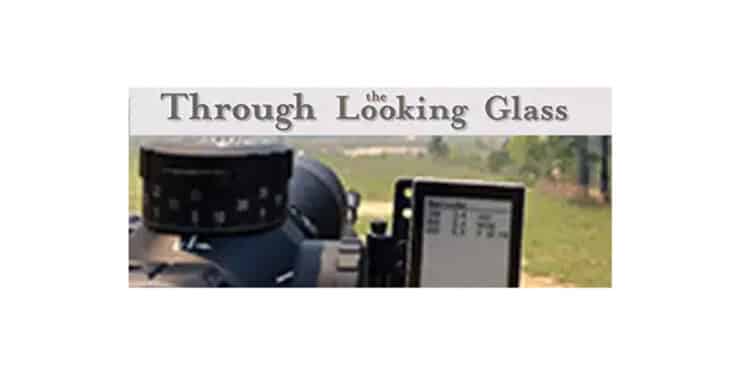By Christopher Rance
Staring hard into the dark, a nine-man team, composed of six light Infantry scouts and three snipers tread carefully through a thick forest of concrete; their shadows follow along the 12-foot blast walls that litter the city as they make their way to a vacant two-story house on the west side of town. Their mission—to set up a final firing point to overwatch a highway and eliminate any threat that might be stirring about.
After infiltration into the vacant structure, the snipers slip off their heavy, burdensome packs and asses their final firing point, knowing that every urban hide must facilitate the following elements: positive communications, concealment, observation and fields of fire, escape routes, method of entry, interlocking sectors of fire and hide security.
After fabricating their hide site, the snipers emplace their M-110 rifles, supported by tripods affixed with HOG Saddle mounts. The tripod allows the sniper to deploy a sniper weapon system in a multitude of battle space environments. The Knights Armament-produced M-110 Semi-Automatic Sniper System is a precision 7.62mm NATO caliber, gas-operated rifle that is highly acclaimed for its battlefield performance. The rifle’s inherent accuracy, ambidextrous controls, abundant MIL-STD-1913 rail mounting capabilities and highly efficient sound suppressor system all contribute to the system’s combat success. Behind a double drape screen, the snipers clip on their universal night sights. The PVS-30 clip-on weapon sight adds the latest high-performance Gen 3 light intensification night vision to their rifles by attaching to the MIL-STD-1913 rail in front of the day optic. This device lets the snipers see at all hours of darkness, in shades of green.
Through the looking glass, the snipers begin their rapid scan and detailed search. The rifle scope that the snipers use is from a company that has been providing optics to the U.S. military since 1985. Leupold & Stevens, Inc. is an American manufacturer of telescopic sights, red dot sights, spotting scopes and binoculars located in Beaverton, Ore. Leupold & Stevens was founded by German immigrant Markus Friedrich Leupold and his brother-in-law Adam Voelpel in 1907, under the name Leupold & Voelpel. In 1942, the company name was changed to its present form, Leupold & Stevens. After World War II, Leupold & Stevens began making rifle scopes. In 1947, Leupold & Stevens introduced their first rifle scope, the Plainsman. It was the first fog-proof scope built by an American company. Fast forward to today, and Leupold’s line of optics are being used by organizations such as the United States Army, United States Navy and the United States Marine Corps. Not only is our military depending on them, but across the United States and abroad, countless military units and law enforcement agencies are putting their trust in them to get the job done.

MARK 5HD
The Leupold Mark 5HD is the latest development in Leupold’s tactical line of rifle scopes. Created with the serious shooter in mind, the Mark 5 pushes the engineering limits with its input from elite military personnel and professional shooters. The Mark 5HD was ergonomically designed with superb tactile, .1 Milliradian (Mil) audible click adjustments and a high-speed throw lever so the professional shooter can put accurate fire downrange faster. The Mark 5HD features a proprietary Argon/Krypton gas blend, which nearly eliminates the effects of thermal shock and reduces the diffusion of gases sealed inside the rifle scope. Its large eyebox provides the shooter exceptional head positioning and overall brightness, facilitating in the shooter gaining an effective sight picture quickly and with relative ease.
Weight: 26oz
Length: 12.06in
Eye Relief (low): 3.54in
Objective Diameter: 2.10in
Eye Relief (high): 3.82in
Tube Diameter: 35mm
Elevation Adjustment: 9.1 Mils
Windage Adjustment: 23.3 Mils
MARK 6 (ECOS-0)
In 2013, the Naval Surface Warfare Center Crane Division in Crane, Ind., awarded a five-year contract to Leupold & Stevens, Inc. and Aimpoint in Chantilly, Va., for the Enhanced Combat Optical Sight-Optimized (ECOS-O) program. The ECOS-O advanced rifle sighting system combines the Leupold & Stevens Mark 6 3-18x44mm rifle scope with the Aimpoint Micro T-1 red-dot aiming system. The Aimpoint Micro T-1 red-dot sighting system uses advanced circuit efficiency technology (ACET) with a light-emitting diode (LED) light source to create a 650-nanometer red light. The ECOS-O design attaches the Aimpoint T-1 sighting device to the top of the Leupold Mark 6 rifle scope. The system is designed to provide optical targeting from zero to 300 meters and optically enhanced targeting from 300 to 1,000 meters for the shooter.
The Leupold Mark 6 is a compact, lightweight rifle scope that features the same proprietary Argon/Krypton gas blend found in the Mark 5HD and an exterior lens surface that is treated with DiamondCoat 2, an ion-assist lens coating, for higher light transmission and excellent abrasion resistance. According to Leupold, the DiamondCoat has the additional advantage of assisting in light transmission, for greater brightness, clarity and contrast. The Mark 6 features a powerful 6:1 zoom ratio that delivers a distinctly clear image throughout the entire magnification range and has a Twin Bias Spring Erector System that features beryllium/copper alloy leaf springs for a 30 percent increased holding force to withstand the most intense recoil and abuse.
The Mark 6, 3-18x44mm M5C2 rifle scope is a waterproof, shockproof and fog proof variable magnification rifle scope featuring audible and tactile 1/10 Mil click adjustments, a Zero-lock elevation adjustment with zero-stop, 34mm main tube, front focal plane TReMoR3 reticle for range estimation and long-range target engagement, side-focus parallax adjustment and optional reticle illumination.
Weight: 23.6oz
Eye Relief: 3.8in
Length: 11.9in
Elevation Adjustment: 26 Mils
Main Tube Diameter: 34mm
Windage Adjustment: 15 Mils
Objective Lens Aperture: 44mm
Adjustment Markings: 1/ 10 Mil

TReMoR3 RETICLE
The TReMoR3 reticle is a first focal plane reticle that magnifies along with the image, so you can estimate range at all magnification settings. The T3 reticle is ideal in tactical situations. The T3 gives the shooter the ability for excellent milling capability with 0.1 Mil resolution milling chevrons, allowing extremely fine estimation. Reticle hold points subtending to 0.2 Mil, with the central targeting grid calibrated in USMC Mils (6283 Mils/circle) (1 Mil= 3.60 inches at 100 yards) (10cm at 100 meters).
The speeds associated with the wind dot markers increase by a specific value from one marker to the next, moving outward from the reticle center. The specific value between wind markers depends on the ballistic coefficient and muzzle velocity. Different sniper weapon systems have different wind marker values. There are seven time-of-flight wind dots on each horizonal stadia line.
For example, an M110 has a wind value of 4, resulting in the following speeds from center outward: 4 miles per hour, 8 miles per hour, 12 miles per hour, 16 miles per hour, 20 miles per hour, 24 miles per hour and ending at 28 miles per hour. It is crucial to recognize that the wind speeds are the same for each drop line. As an example, the third wind marker speed equals 12 miles per hour for an M110 weapon system regardless of which drop line it occurs on. This means that no further calculations are required to place wind holds for different drop adjustments.
To determine the wind dot value of your system, in your Applied Ballistic engine, turn off the spin drift calculation, then find the range in which 4 Mils is your elevation hold. Adjust the full wind value until you have as close to a .95 Mil hold as you can.
SPUHR MOUNT
The Spuhr mount is an extremely sturdy scope mount, with the possibility to attach multiple optical accessories directly to the mount. The mount has a built-in bubble level to help offset shooter-induced cant. A 45-degree split of the rings provides unobstructed view of the knobs. The sniper’s rifle and the spotter’s carbine can have the same mount, enabling the use of the same or shared equipment and accessories.
Traditionally weapon-mounted lasers have been mounted on the forend of the rifle, a solution with drawbacks. For the same reasons you don’t want your barrel to touch the forend you don ?t want the sights to be mounted on the forend. The Spuhr mounting system has up to seven interfaces for accessories, and the laser can be easily attached to the scope mount, providing the advantage of an undisturbed laser and having the weight close to the center of the gun instead of forward.
For weapon-mounted laser rangefinders, the direct-view optics are decoupled from the laser rangefinder itself. The sniper must manually align the laser rangefinder (LRF). Improper alignment results in poor ranging capability as well as inaccurate range measurements. To take full advantage of LRF performance, snipers want to ensure that a maximum amount of the laser energy is focused on the target and not scattering off of adjacent areas. At 1000 meters, if the laser rangefinder is misaligned 0.5 Mil low, this could result in an error in the range measurement of up to 5 meters, which could drop the probability of hitting the target by as much as 30 to 40 percent. Weapon-mounted LRFs rely on the rifle scope’s reticle for alignment. If the sniper dials windage or elevation corrections for ballistics, it will ruin the reticle’s alignment with the laser.

E-DOPE READER
The E-Dope is an electronic display used to clearly display target data. Utilizing E-Paper technology, the display is sunlight readable at extreme angles. The display is battery-less, utilizing NFC technology from your Android device to update the display. The E-Dope display is intended for fast-paced target shooting where multiple targets are to be engaged under time constraints. The display uses the E-Dope and Kestrel Ballistic Link Android applications. The E-Dope application allows you to save an indefinite list of stages with multiple targets. This allows the user to pre-save target distances, elevation and wind holds and load them to the E-Dope display when needed.
Using the E-Dope card is easy. Simply input all your required data into either the E-Dope application or the Kestrel Ballistics Link application. Hold the back of your Android device to the front of the E-Dope card. You will get a status bar showing the transfer progress and a message stating “Transfer Complete.”
Dimensions: 2.13in x 3.37in x 0.145in
Viewable Screen Size: 2.9in
IP54 rated: Dust- and Water-Re-sistant
Operating Temp: -10°F to 130°F
Attachment Method: Hook and Loop
Data Transfer: Android Application
ENGAGEMENT CYCLE
Once in the firing position, both the sniper and the observer are responsible for ensuring the sniper hits the target with one shot. The key to success is communication. The sniper team members may communicate however they feel comfortable, as long as their means of communication are effective and concise. With the assistance of the E-DOPE, Applied Ballistic software, a weapon-mounted laser rangefinder, and the robust design of the Leupold rifle scope, the sniper team is able to quickly begin the engagement cycle, which consist of four steps:
Step 1. Target identification—The sniper team identifies and determines that engagement is needed or a leader has directed it.
Step 2. Target acquisition—The sniper team makes the following assessment: Positive identification, weapon capability and individual proficiency.
Step 3. Target engagement—Sniper teams use the shot process and the functional elements of the shot process to engage a target.
Step 4. Target assessment—Sniper teams assess the effects on target and situation.
As dawn breaks over the horizon, the sniper team identifies an enemy combatant emplacing an IED on the side of the road. The team radios to command, informing them of the situation unfolding. Given the green light to engage, the sniper confirms the target distance via his weapon-mounted laser rangefinder, and by quickly glancing at the E-DOPE reader, he holds over the respected Mils in his TReMoR3 reticle and peers through his Leupold rifle scope; with the bend of his index finger, a shot hisses out from the end of the suppressed barrel. Like ripples in a pond, the spotter sees the trace of the bullet traveling at supersonic speed. The tiny projectile arriving to do its job well before the sound does and in less than a second, the enemy combatant is neutralized. The sniper team radios back to command and continues to scan for targets of opportunity.
| This article first appeared in Small Arms Review V22N7 (August 2018) |












